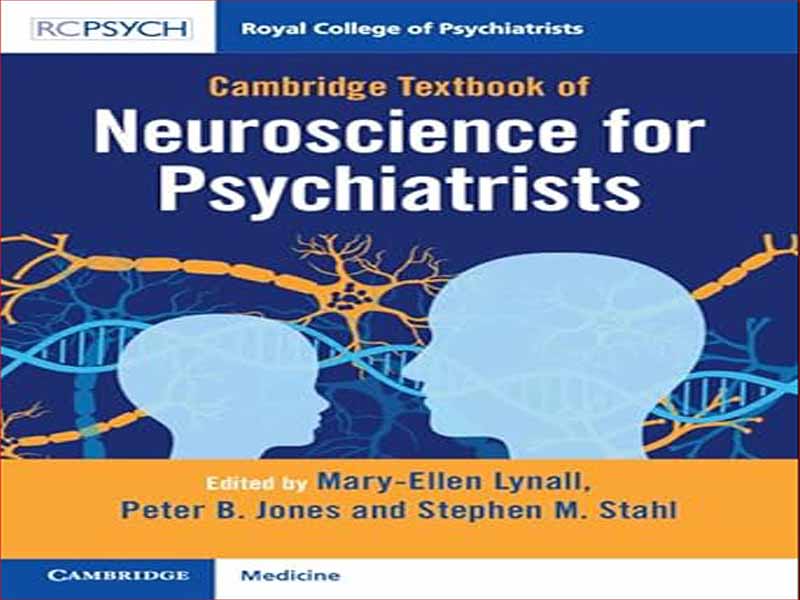- عنوان کتاب: CAMBRIDGE TEXTBOOK OF Neuroscience for Psychiatrists
- نویسنده/انتشارات: Mary Ellen
- حوزه: روانپزشکی
- سال انتشار: 2024
- تعداد صفحه: 615
- زبان اصلی: انگلیسی
- نوع فایل: pdf
- حجم فایل: 44.8 مگابایت
در 100 سال گذشته انقلابی در درک ما از مغز رخ داده است. تا کنون، این کار چندانی برای اختلال در عملکرد روانپزشکی رایج انجام نداده است. که قرار است تغییر کند. درمانهای جدید مبتنی بر علوم اعصاب در حال ظهور هستند، در حالی که شواهدی از علوم اعصاب و ژنتیک مرزهای تشخیصی سنتی را زیر سوال میبرند. روانپزشکان آینده باید درک خود را از تصویربرداری مغز، تشخیص مولکولی، عوامل روانشناختی و زمینه اجتماعی برای ارائه برنامههای مراقبتی مبتنی بر علوم اعصاب یکپارچه کنند. با توجه به تغییرات پیش رو و نیاز به آموزش نسل بعدی روانپزشکان در علوم اعصاب مدرن، بنیاد گتسبی، ولکام و کالج سلطنتی روانپزشکان بریتانیا هیئتی از متخصصان را تحت مدیریت درخشان پروفسور وندی برن و مایک گرد هم آوردند. تراویس خلاصه آنها توسعه و اجرای یک برنامه درسی جدید علوم اعصاب برای روانپزشکان در آموزش آماده سازی برای عضویت در آزمون حرفه ای کالج سلطنتی روانپزشکان (MRCPsych) بود. کتاب درسی علوم اعصاب کمبریج برای روانپزشکان همراه با برنامه درسی جدید است و باید به عنوان یک «فروشگاه واحد» برای آنچه که هر روانپزشکی باید در مورد مغز بداند عمل کند. درک مغز و ذهن به مجموعه وسیعی از تکنیک ها و رویکردهای مفهومی نیاز دارد. در این کتاب، دانشمندان علوم اعصاب، متخصصین ژنتیک، روانشناسان، روانپزشکان، متخصصان مغز و اعصاب، جراحان مغز و اعصاب و متخصصان غدد را گرد هم آورده ایم تا لبه برش علوم اعصاب ترجمه ای را با تمرکز بر پرداختن به مطالب مرتبط با عملکرد روانپزشکی فعلی یا آینده به شما ارائه دهیم. بسیاری از مطالب برگرفته از سخنرانیهایی است که برای تدریس در مقطع کارشناسی و بالینی توسط دانشکده علوم اعصاب کمبریج و همکاران آنها در خارج از دانشگاه تهیه شده است. ما از همه آنها برای مشارکت سخاوتمندانه آنها تشکر می کنیم. کتاب با فصل هایی در مورد علوم اعصاب اولیه سلول ها و سیناپس ها آغاز می شود. مجموعه ای از روش های مورد استفاده در علوم اعصاب؛ و نوروآناتومی مربوط به روانپزشکان است. ما مدارها و تعدیلکنندههای مغز را در نظر میگیریم که زیربنای عملکردهای مرتبط با روانپزشکی مانند پاسخهای استرس، انگیزه، خواب و همدلی هستند. ما اصول اولیه رشد عصبی و مدل های رشدی اختلالات روانپزشکی را بیان می کنیم. در نهایت، علوم اعصاب هر یک از تشخیصهای اصلی روانپزشکی را در نظر میگیریم. توصیه می کنیم در حین ایجاد دانش، با استفاده از ارجاعات متقابل ارائه شده، بین این بخش ها حرکت کنید. برای مثال، اگر به علوم اعصاب اختلال وسواس فکری-اجباری (OCD) علاقه دارید، میتوانید با بخش OCD شروع کنید، به مطالعه بخش مدار عصبی عادتها برگردید، نوروآناتومی جسم مخطط و لوب فرونتال را مرور کنید. ، سپس به مطالعه بخش علوم اعصاب تحریک مغز بروید. علیرغم ادبیات گسترده علوم اعصاب، ما تازه شروع به درک علم اعصاب علائم، سندرم ها و درمان های روانپزشکی کرده ایم. ما سعی کردهایم این موضوع را در کتاب درسی منعکس کنیم، آنچه شناخته شده است را نشان دهیم، اما همچنین جنبههای روانپزشکی را که کمتر درک شدهاند، و سؤالات برجسته کلیدی در هر زمینه را برجسته کنیم. فصلهای ما با برنامه درسی علوم اعصاب تولید شده تحت پروژه علوم اعصاب Gatsby-Wellcome-RCPsych که در بالا توضیح داده شد، هماهنگ هستند و به برنامه درسی از ابتکار برنامه درسی علوم اعصاب ملی ایالات متحده (NNCI) پیوند میخورند. در سرتاسر کتاب، کدهای QR به منابع آنلاین مربوطه از NNCI پیوند دارند. ما از دیوید راس و مایک تراویس در NNCI برای بحث در طول تولید این کتاب و ارائه پیوندهای سخت که به ما امکان می دهد با منابع خارق العاده آنها یکپارچه شویم سپاسگزاریم. ما همچنین مدیون تیم درخشان خود از داوران همتا هستیم، عمدتاً کارآموزان روانپزشکی، که بازخورد قاطع آنها برای توسعه این فصلها، افزایش دسترسی و ارتباط بالینی آنها مفید بود. ما از دکتر گرت کاتل در کالج سلطنتی روانپزشکان برای هماهنگی این فرآیند سپاسگزاریم.
In the past 100 years there has been a revolution in our understanding of the brain. So far, this has done little to disrupt mainstream psychiatric practice. That is set to change. New neuroscience-based treatments are emerging, while evidence from neuroscience and genetics is calling into question traditional diagnostic boundaries. Psychiatrists of the future will need to integrate their understanding of brain imaging, molecular diagnostics, psychological factors and social context to provide neuroscience- informed care plans. In recognition of the changes to come, and the need to train the next generation of psychiatrists in modern neuroscience, the Gatsby Foundation, Wellcome and the UK Royal College of Psychiatrists brought together a board of experts under the brilliant direction of Professors Wendy Burn and Mike Travis. Their brief was to develop and implement a new neuroscience curriculum for psychiatrists in training preparing for the Membership of the Royal College of Psychiatrists (MRCPsych) professional examination. The Cambridge Textbook of Neuroscience for Psychiatrists accompanies that new curriculum and should serve as a ‘one-stop shop’ for what any psychiatrist needs to know about the brain. Understanding the brain and mind requires a vast array of techniques and conceptual approaches. In this book, we have brought together basic neuroscientists, geneticists, psychologists, psychiatrists, neurologists, neurosurgeons and endocrinologists to bring you the cutting edge of translational neuroscience, focused on addressing the material most relevant to current or future psychiatric practice. Much of the material draws on the lectures prepared for undergraduate and clinical teaching by the faculty of Cambridge Neuroscience and their collaborators beyond the university. We thank them all for their generous contributions. The book opens with chapters on the basic neuroscience of cells and synapses; the array of methods used in neuroscience; and the neuroanatomy most relevant to psychiatrists. We move on to consider the brain circuits and modulators which underlie functions relevant to psychiatry such as stress responses, motivation, sleep and empathy. We outline the basics of neural development and developmental models of psychiatric disorders. Finally, we consider the neuroscience of each of the major psychiatric diagnoses. We recommend moving back and forth between these sections as you build your knowledge, using the cross-references provided. For example, if you are interested in the neuroscience of obsessive–compulsive disorder (OCD), you might start with the section on OCD, go back to read the section on the neural circuitry of habits, recap the neuroanatomy of the striatum and frontal lobes, then move on to read the section on the neuroscience of brain stimulation. Despite the vast neuroscientific literature, we are only beginning to understand the neuroscience of psychiatric symptoms, syndromes and treatments. We’ve tried to reflect this in the textbook, showcasing what is known, but also highlighting aspects of psychiatry that are less well understood, and key outstanding questions in each area. Our chapters align with the neuroscience syllabus generated under the Gatsby–Wellcome–RCPsych Neuroscience Project described above, and link to the curriculum from the USA National Neuroscience Curriculum Initiative (NNCI). Throughout the book, QR codes link out to relevant online resources from the NNCI. We are grateful to David Ross and Mike Travis at NNCI for discussions during the production of this book and for providing the hard links allowing us to integrate with their fantastic resources. We are also hugely indebted to our brilliant team of peer reviewers, mainly psychiatry trainees, whose incisive feedback was instrumental to the development of these chapters, honing their accessibility and clinical relevance. We are grateful to Dr Gareth Cuttle at the Royal College of Psychiatrists for coordinating this process.
این کتاب را میتوانید از لینک زیر بصورت رایگان دانلود کنید:
Download: CAMBRIDGE TEXTBOOK OF Neuroscience for Psychiatrists



































نظرات کاربران